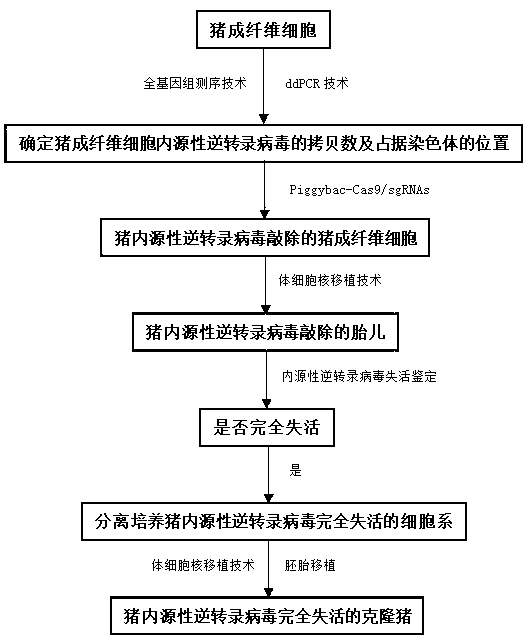Construction method of cloned pig in which porcine endogenous retrovirus is inactivated
A technology of retrovirus and construction method, which is applied in the field of construction of porcine endogenous retrovirus inactivated cloned pigs, can solve the problems of slow cell growth, low success rate of cell lines, unavoidable risk of PERV infection, etc., and achieve Speed up the research process, solve safety problems, and overcome inefficiencies
- Summary
- Abstract
- Description
- Claims
- Application Information
AI Technical Summary
Problems solved by technology
Method used
Image
Examples
Embodiment 1
[0023] A method for constructing porcine endogenous retrovirus inactivated cloned pigs, the specific operation process is carried out according to the following steps:
[0024] 1) Determine the copy number and chromosomal position occupied by porcine endogenous retroviruses
[0025] Through the comparison of ddPCR and whole-genome sequencing, the copy number of PERV in the genome of pig fetal fibroblasts and its position on the chromosome were determined;
[0026] 2) Construct a gene targeting system for the porcine endogenous retrovirus Pol gene sequence
[0027] Using CRISPR / Cas9 gene editing technology to construct targeting sgRNA for the porcine endogenous retrovirus Pol gene sequence, and knock out the porcine endogenous retrovirus pol gene to inactivate the porcine endogenous retrovirus;
[0028] 3) Screening to obtain cell lines that inactivate porcine endogenous retroviruses
[0029] Transfect the constructed porcine endogenous retrovirus inactivation vector into a p...
Embodiment 2
[0034] A method for constructing porcine endogenous retrovirus inactivated cloned pigs, the specific operation process is carried out according to the following steps:
[0035] 1) Determine the copy number and chromosomal position occupied by porcine endogenous retroviruses
[0036] Through the comparison of ddPCR and whole-genome sequencing, the copy number of PERV in the genome of pig fetal fibroblasts and its position on the chromosome were determined;
[0037] 2) Construct a gene targeting system for the porcine endogenous retrovirus Pol gene sequence
[0038] Using CRISPR / Cas9 gene editing technology to construct targeting sgRNA for the porcine endogenous retrovirus Pol gene sequence, and knock out the porcine endogenous retrovirus pol gene to inactivate the porcine endogenous retrovirus;
[0039] 3) Screening to obtain cell lines that inactivate porcine endogenous retroviruses
[0040] Transfect the constructed porcine endogenous retrovirus inactivation vector into a p...
PUM
 Login to View More
Login to View More Abstract
Description
Claims
Application Information
 Login to View More
Login to View More - R&D
- Intellectual Property
- Life Sciences
- Materials
- Tech Scout
- Unparalleled Data Quality
- Higher Quality Content
- 60% Fewer Hallucinations
Browse by: Latest US Patents, China's latest patents, Technical Efficacy Thesaurus, Application Domain, Technology Topic, Popular Technical Reports.
© 2025 PatSnap. All rights reserved.Legal|Privacy policy|Modern Slavery Act Transparency Statement|Sitemap|About US| Contact US: help@patsnap.com

